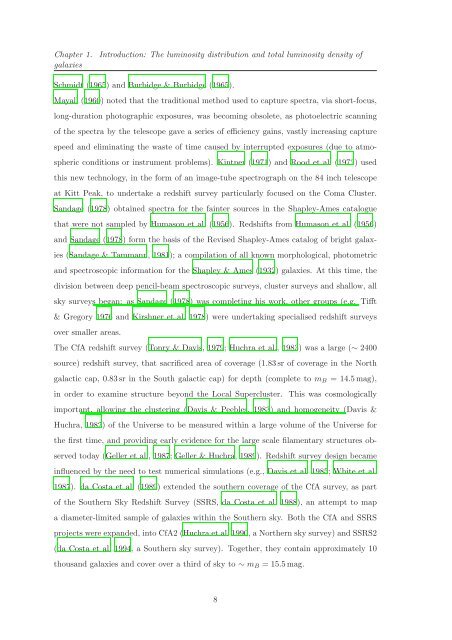David Thomas Hill PhD Thesis - Research@StAndrews:FullText ...
David Thomas Hill PhD Thesis - Research@StAndrews:FullText ...
David Thomas Hill PhD Thesis - Research@StAndrews:FullText ...
You also want an ePaper? Increase the reach of your titles
YUMPU automatically turns print PDFs into web optimized ePapers that Google loves.
Chapter 1. Introduction: The luminosity distribution and total luminosity density of<br />
galaxies<br />
Schmidt (1965) and Burbidge & Burbidge (1965).<br />
Mayall (1960) noted that the traditional method used to capture spectra, via short-focus,<br />
long-duration photographic exposures, was becoming obsolete, as photoelectric scanning<br />
of the spectra by the telescope gave a series of efficiency gains, vastly increasing capture<br />
speed and eliminating the waste of time caused by interrupted exposures (due to atmo-<br />
spheric conditions or instrument problems). Kintner (1971) and Rood et al. (1972) used<br />
this new technology, in the form of an image-tube spectrograph on the 84 inch telescope<br />
at Kitt Peak, to undertake a redshift survey particularly focused on the Coma Cluster.<br />
Sandage (1978) obtained spectra for the fainter sources in the Shapley-Ames catalogue<br />
that were not sampled by Humason et al. (1956). Redshifts from Humason et al. (1956)<br />
and Sandage (1978) form the basis of the Revised Shapley-Ames catalog of bright galax-<br />
ies (Sandage & Tammann, 1981); a compilation of all known morphological, photometric<br />
and spectroscopic information for the Shapley & Ames (1932) galaxies. At this time, the<br />
division between deep pencil-beam spectroscopic surveys, cluster surveys and shallow, all<br />
sky surveys began: as Sandage (1978) was completing his work, other groups (e.g. Tifft<br />
& Gregory 1976 and Kirshner et al. 1978) were undertaking specialised redshift surveys<br />
over smaller areas.<br />
The CfA redshift survey (Tonry & Davis, 1979; Huchra et al., 1983) was a large (∼ 2400<br />
source) redshift survey, that sacrificed area of coverage (1.83sr of coverage in the North<br />
galactic cap, 0.83sr in the South galactic cap) for depth (complete to mB = 14.5mag),<br />
in order to examine structure beyond the Local Supercluster. This was cosmologically<br />
important, allowing the clustering (Davis & Peebles, 1983) and homogeneity (Davis &<br />
Huchra, 1982) of the Universe to be measured within a large volume of the Universe for<br />
the first time, and providing early evidence for the large scale filamentary structures ob-<br />
served today (Geller et al., 1987; Geller & Huchra, 1989). Redshift survey design became<br />
influenced by the need to test numerical simulations (e.g., Davis et al. 1985; White et al.<br />
1987). da Costa et al. (1989) extended the southern coverage of the CfA survey, as part<br />
of the Southern Sky Redshift Survey (SSRS, da Costa et al. 1988), an attempt to map<br />
a diameter-limited sample of galaxies within the Southern sky. Both the CfA and SSRS<br />
projects were expanded, into CfA2 (Huchra et al. 1990, a Northern sky survey) and SSRS2<br />
(da Costa et al. 1994, a Southern sky survey). Together, they contain approximately 10<br />
thousand galaxies and cover over a third of sky to ∼ mB = 15.5mag.<br />
8

















